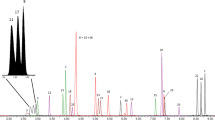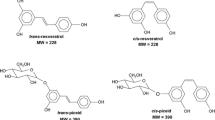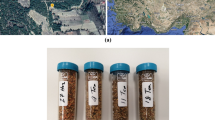Abstract
Beehive products, particularly pollen, are among the foodstuffs that may contain pyrrolizidine alkaloids (PAs), prompting concern due to their negative effects on humans, such as hepatotoxic potential. Based on these aspects, this study represents the first investigation into eight PAs present in samples of bee bread (n = 16) and commercial pollens (n = 15) from Brazil utilizing liquid chromatography coupled to mass spectrometry in tandem. Our findings showed the presence of at least two PAs in all samples analyzed (n = 31), with monocrotaline, senecionine, senecionine N-oxide, and retrorsine emerging as the most frequently abundant in the Brazilian samples. The PAs sum varied widely (from 268 to 263,849 µg kg−1), with 77.4% of the samples exceeding the maximum limit established by the European Union (500 µg kg−1). Therefore, this study demonstrates that bee pollen and bee bread are foods with high levels of PAs and highlights that further studies related to PAs and beehive products are necessary so that actions are taken to minimize risks to consumers and safeguard the beekeeping industry.
Similar content being viewed by others
References
Brugnerotto P, Seraglio SKT, Schulz M et al (2021) Pyrrolizidine alkaloids and beehive products: a review. Food Chem 342:128384
Tamariz J, Burgueño-Tapia E, Vázquez MA, Delgado F (2018) Chapter one–pyrrolizidine alkaloids. In: Knölker H-J (ed) The alkaloids: chemistry and biology. Elsevier, New York
Casado N, Morante-Zarcero S, Sierra I (2022) The concerning food safety issue of pyrrolizidine alkaloids: an overview. Trends Food Sci Technol 120:123–139
Végh R, Csóka M, Sörös C, Sipos L (2021) Food safety hazards of bee pollen—a review. Trends Food Sci Technol 114:490–509
Aronson JK (2016) Pyrrolizidine alkaloids. In: Aronson JK (ed) Meyler’s side effects of drugs, 16 th edn. Elsevier, New York
Buchmueller J, Enge A-M, Peters A et al (2022) The chemical structure impairs the intensity of genotoxic effects promoted by 1,2-unsaturated pyrrolizidine alkaloids in vitro. Food Chem Toxicol 164:113049
Ning J, Chen L, Strikwold M et al (2019) Use of an in vitro–in silico testing strategy to predict inter-species and inter-ethnic human differences in liver toxicity of the pyrrolizidine alkaloids lasiocarpine and riddelliine. Arch Toxicol 93:801–818
He Y, Ma J, Fan X et al (2021) The key role of gut–liver axis in pyrrolizidine alkaloid-induced hepatotoxicity and enterotoxicity. Acta Pharm Sin B 11:3820–3835
Xu J, Wang W, Yang X et al (2019) Pyrrolizidine alkaloids: an update on their metabolism and hepatotoxicity mechanism. Liver Res 3:176–184
Dusemund B, Nowak N, Sommerfeld C et al (2018) Risk assessment of pyrrolizidine alkaloids in food of plant and animal origin. Food Chem Toxicol 115:63–72
EFSA Contam Panel, Knutsen HK, Alexander J et al (2017) Statement on the risks for human health related to the presence of pyrrolizidine alkaloids in honey, tea, herbal infusions and food supplements. EFSA J 15:4908
Jansons M, Fedorenko D, Pavlenko R et al (2022) Nanoflow liquid chromatography mass spectrometry method for quantitative analysis and target ion screening of pyrrolizidine alkaloids in honey, tea, herbal tinctures, and milk. J Chromatogr A 1676:463269
European Commission (2020) Commission Regulation (EU) 2020/2040 of 11 December 2020 amending regulation (EC) No 1881/2006 as regards maximum levels of pyrrolizidine alkaloids in certain foodstuffs. https://eur-lex.europa.eu/legal-content/EN/TXT/HTML/?uri=CELEX:32020R2040&rid=1. Accessed 20 Oct 2022
Seraglio SKT, Silva B, Bergamo G et al (2019) An overview of physicochemical characteristics and health-promoting properties of honeydew honey. Food Res Int 119:44–66
Kast C, Kilchenmann V, Reinhard H et al (2019) Pyrrolizidine alkaloids: The botanical origin of pollen collected during the flowering period of Echium vulgare and the stability of pyrrolizidine alkaloids in bee bread. Molecules 24:2214
Aylanc V, Tomás A, Russo-Almeida P et al (2021) Assessment of bioactive compounds under simulated gastrointestinal digestion of bee pollen and bee bread: bioaccessibility and antioxidant activity. Antioxidants 10:651
Friedle C, Kapp T, Wallner K et al (2022) High abundance of pyrrolizidine alkaloids in bee pollen collected in July 2019 from Southern Germany. Environ Monit Assess 194:250
Martinello M, Manzinello C, Gallina A, Mutinelli F (2022) In-house validation and application of UHPLC-MS/MS method for the quantification of pyrrolizidine and tropane alkaloids in commercial honey bee-collected pollen, teas and herbal infusions purchased on Italian market in 2019–2020 referring to recent European Union regulations. Int J Food Sci Technol 57:7505–7516
Rizzo S, Celano R, Campone L et al (2022) Salting-out assisted liquid-liquid extraction for the rapid and simple simultaneous analysis of pyrrolizidine alkaloids and related N-oxides in honey and pollen. J Food Compos Anal 108:104457
Valese AC, Daguer H, Muller CMO et al (2021) Quantification of pyrrolizidine alkaloids in Senecio brasiliensis, beehive pollen, and honey by LC-MS/MS. J Environ Sci Health Part B 56:685–694
Brugnerotto P, Dortzbach D, Blainski É et al (2021) Identificação de plantas com potencial apícola provenientes de sistemas de monitoramento de colmeias no estado de Santa Catarina, Brasil. Res Soc Dev 10:1–16
Coradin L, Siminski A, Reis A (2011) Espécies nativas da flora brasileira de valor econômico atual ou potencial: plantas para o futuro—Região Sul, 1st edn. MMA, Brasília
Nishida SM, Naide SS, Pagnin D (2014) Plantas que atraem aves e outros bichos, 1st edn. Cultura Acadêmica, São Paulo
Pirani JR, Cortopassi-Laurino M (1994) Flores e abelhas em São Paulo, 2nd edn. USP & FAPESP, São Paulo
Ghosh S, Jeon H, Jung C (2020) Foraging behaviour and preference of pollen sources by honey bee (Apis mellifera) relative to protein contents. J Ecol Environ 44:1–7
De Jesus IL, Lanza I, Merlanti R et al (2020) Discriminant analysis of pyrrolizidine alkaloid contamination in bee pollen based on near-infrared data from lab-stationary and portable spectrometers. Eur Food Res Technol 246:2471–2483
EFSA (2009) European food safety authority; compendium of botanicals that have been reported to contain toxic, addictive, psychotropic or other substances of concern on request of EFSA. EFSA J 7:281
Letsyo E, Jerz G, Winterhalter P, Beuerle T (2017) Toxic pyrrolizidine alkaloids in herbal medicines commonly used in Ghana. J Ethnopharmacol 202:154–161
Boppré M, Colegate SM, Edgar JA, Fischer OW (2008) Hepatotoxic pyrrolizidine alkaloids in pollen and drying-related implications for commercial processing of bee pollen. J Agric Food Chem 56:5662–5672
Kaltner F, Rychlik M, Gareis M, Gottschalk C (2018) Influence of storage on the stability of toxic pyrrolizidine alkaloids and their N-oxides in peppermint tea, hay, and honey. J Agric Food Chem 66:5221–5228
de Camargo RCR (2002) Sistemas de produção 3–produção de mel, 1st edn. Embrapa Meio-Norte, Teresina
Vasconcelos ECG, Silva VL, do Bendini JN et al (2021) Diversidade florística de espécies com potencial apícola no município de Cocal, região norte do Piauí. Braz J Agroecol Sustain 2:83–98
da Silva GV, da Santos AS, de Silva KJM et al (2020) Levantamento de plantas invasoras com potencial apícola em área de plantio de moringa. Meio Ambiente (Brasil) 2:37–46
Lopes CGR, Beirão DCC, Pereira LA, Alencar LC (2016) Levantamento da flora apícola em área de cerrado no município de Floriano, estado do Piauí, Brasil. R Bras Bioci 14:102–110
Inacio LDJ, Merlanti R, Lucatello L et al (2020) Pyrrolizidine alkaloids in bee pollen identified by LC-MS/MS analysis and colour parameters using multivariate class modeling. Heliyon 6:e03593
Picron JF, Herman M, van Hoeck E, Goscinny S (2020) Monitoring of pyrrolizidine alkaloids in beehive products and derivatives on the Belgian market. Environ Sci Pollut Res 27:5693–5708
Dübecke A, Beckh G, Lüllmann C (2011) Pyrrolizidine alkaloids in honey and bee pollen. Food Addit Contam Part A 28:348–358
Mulder PPJ, López P, Castelari M et al (2018) Occurrence of pyrrolizidine alkaloids in animal- and plant-derived food: Results of a survey across Europe. Food Addit Contam Part A 35:118–133
Mulder PPJ, Sánchez PL, These A et al (2015) Occurrence of pyrrolizidine alkaloids in food. EFSA Support Publ 12(8):859E
Kast C, Kilchenmann V, Reinhard H et al (2018) Chemical fingerprinting identifies Echium vulgare, Eupatorium cannabinum and Senecio spp. as plant species mainly responsible for pyrrolizidine alkaloids in bee-collected pollen. Food Addit Contam Part A 35:316–327
Lucchetti MA, Glauser G, Kilchenmann V et al (2016) Pyrrolizidine alkaloids from Echium vulgare in honey originate primarily from floral nectar. J Agric Food Chem 64:5267–5273
Funding
The authors would like to thank Coordenação de Aperfeiçoamento de Pessoal de Nível Superior – Brazil (Finance code 001), Fundação de Amparo à Pesquisa e Inovação do Estado de Santa Catarina (No. 88887.178578/2018-00), and Conselho Nacional de Desenvolvimento Científico e Tecnológico – Brazil (No. 150058/2021-7, No. 309702/2022-4, No. 152333/2022-3).
Author information
Authors and Affiliations
Corresponding authors
Ethics declarations
Conflicts of interest
The authors have no conflict of interest to declare.
Compliance with ethics requirements
Not applicable.
Additional information
Publisher's Note
Springer Nature remains neutral with regard to jurisdictional claims in published maps and institutional affiliations.
Supplementary Information
Below is the link to the electronic supplementary material.
Rights and permissions
Springer Nature or its licensor (e.g. a society or other partner) holds exclusive rights to this article under a publishing agreement with the author(s) or other rightsholder(s); author self-archiving of the accepted manuscript version of this article is solely governed by the terms of such publishing agreement and applicable law.
About this article
Cite this article
Seraglio, S.K.T., Brugnerotto, P., Deolindo, C.T.P. et al. LC–MS/MS analysis of pyrrolizidine alkaloids in bee bread and commercial pollen from Brazil. Eur Food Res Technol (2024). https://doi.org/10.1007/s00217-024-04573-1
Received:
Revised:
Accepted:
Published:
DOI: https://doi.org/10.1007/s00217-024-04573-1




